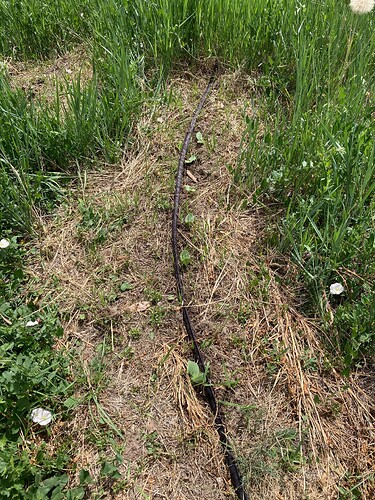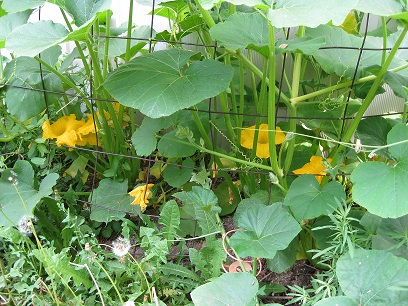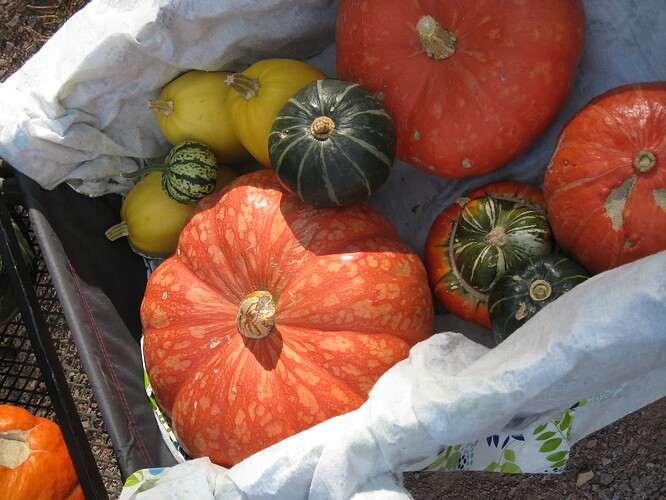Hi, Debbie,
I ordered the c maxima and c moschata seeds from Going To Seed, and added them to my own grexes. In mid-April, I started 72 triple-seed sets (1 max, 1 moschata, and 1 pepo seed in each cell of the start-tray), planted in dried moss and perlite, watered with snow-melt, and placed in a south-facing window in my living room. My rationale for starting species together is that I want the most competitive starts to prevail. My rationale for using transplants rather than direct seeding is that I have a growing season of 104-133 days.
My pepo grex is acorn and carnival (next year I plan to add “Thelma Sanders”), and my moschata grex includes some “upper ground sweet potato” squash seeds and butternut seeds. My maxima grex includes turks turban, rouge vid tempes, buttercup, and japanese kabocha seeds.
The start-sets were well up by mid-May, so I hardened them off and got them planted as soon as I was sure the frost was over. My soil prep ranged from absolute zero (poked a hole in the ground and put the start-set in it) to the very best care I could give without chemical fertilizers: I processed my own potassium from locally quarried and screened (300 mesh) potassium feldspar, catalyzed it by wrapping in aluminum foil with eggshells and hydrochloric acid, and roasting in the fire-pit, then ground it fine with bone char. This phosphate/potassium supplement was mixed with my own compost that had been building since Fall (with generous deer and rabbit poop) soaked in “nitro-p” (urine diluted with water,) perlite, broken terra cotta shards and dried moss. My rationale for the inputs I used is that I don’t yet know what the minimal productive level of care is here, so I need to learn what the absolute minimum level is. Over the next few years, I plan to find the sweet spot between total neglect and a healthy crop in the limited space I have.
Planting sites ranged from:
FULL SUN:
12-inch deep holes, the soil from which was mixed in equal parts with the above supplement, then returned to the holes. These holes were placed 3-4 ft apart. Each hole was planted with a single start-set.
Between the above holes, a single divot about 3 inches deep was made in the unprepared ground with a sharp stick. Each of these holes was planted with a start-set. My rationale for crowding is that I have limited growin space, so I want plants that can produce a crop while coping with crowded conditions.
Along a south-facing shed wall, a 3 inch mat of well-aged, urine soaked grass clippings (pulled from the bottom of my over-wintered compost) was laid on the unprepared ground, covered with 3 inches of the homemade phosphorus/potassium supplement mix, and planted with 10 start-sets.
Along the same wall, a 4-inch deep layer of compost was laid down on the unprepared ground and planted with 10 start-sets.
PARTIAL SHADE:
In a location receiving morning sun only:
Three mounds of the above supplement mix were laid 3 inches high over 3-inch deep divots, 3 ft apart. These were each planted with a start-set.
Between the above mounds, start-sets were planted in 3-inch deep divots in unprepared ground.
In a location receiving evening sun only:
Young weeds were removed from a 25 sq ft patch of otherwise unprepared ground, which was then planted with 10 start-sets.
ADDITIONAL TRIALS:
In a patch of native prairie tallgrass, 5 start-sets were planted in an old tire ringed with wire trellis in existing soil topped with 3 inches of my phosphorus/potassium supplement.
5 start-sets were planted along a west-facing concrete wall in 3 inch divots in a bed of clover.
Both start-sets and seeds were also planted in a variety of marginal locations in shallow divots in unprepared ground.
NOTES: I lost very few start-sets to transplant shock (maybe 5 or 6 out of 72), and also a few were lost among the weeds in some marginal locations. I have edible weeds (dandelion, burdock, Dames Rocket, nettle, lamb’s quarter,) medicinals (yarrow) and herbal teas (cat mint), and native plant species that I want to foster- so I don’t generally pull, chop, or otherwise curtail weeds at all, except in limited spots for initial soil preparation.
This has been our wettest Spring here in years (Hot Springs, SD) so I have only had to water once with city water. I dilute my “nitro-p” with rain water from a 50 gallon catch-barrel, at about 20 parts water.
When my squash plants in a given location reach the point of pushing blossoms, I start adding a weak (5%) solution of vinegar (acetic acid) to the nitro-p in order to neutralize the nitrogen (ammonium), leaving the phosphorus and potassium available to the plants. This also helps to lower the ph a bit by the splitting the sodium chloride in the urine to produce a very mild solution of hydrochloric acid.
Not surprisingly, a month after planting, the plants showing the best start and the earliest blossoms are in the most direct sun with the most prepared soil.
















